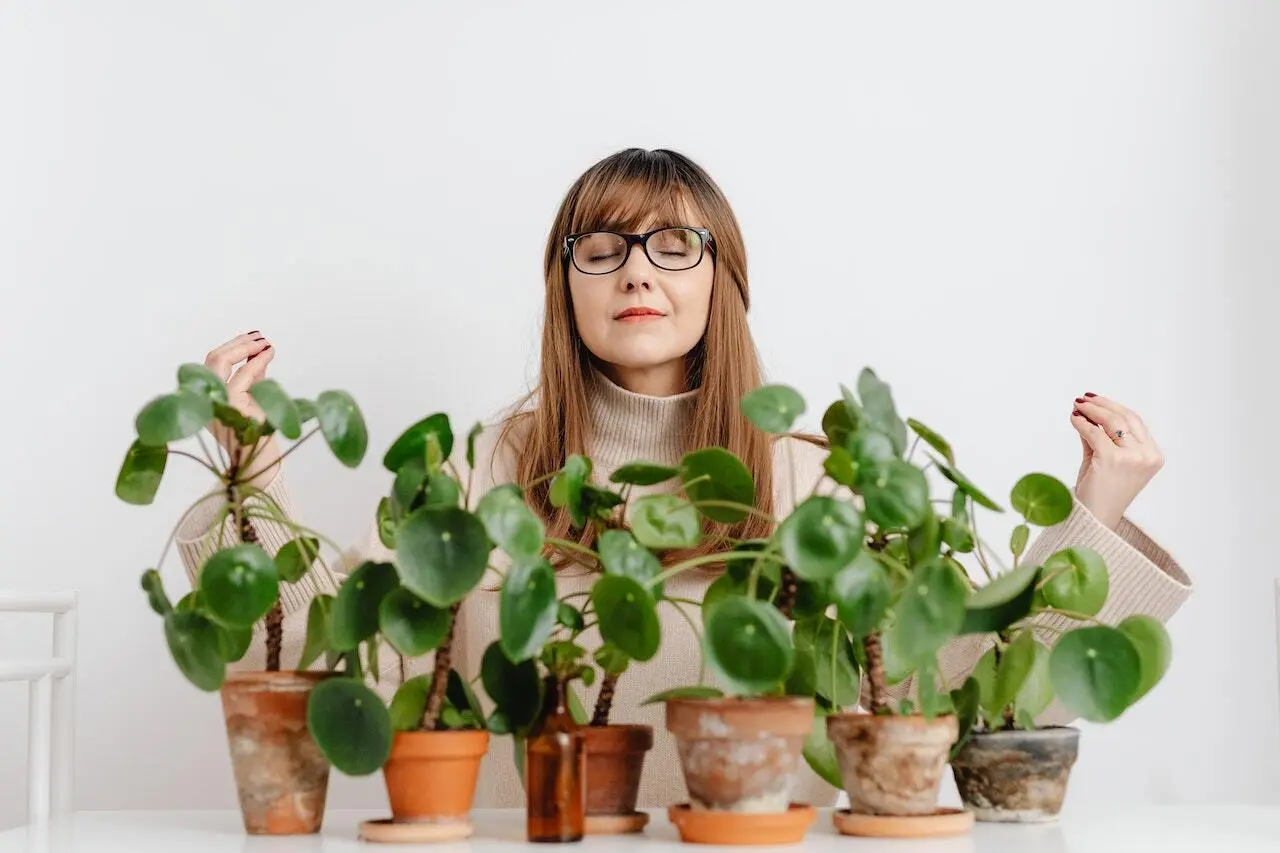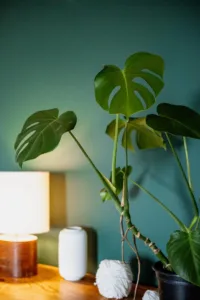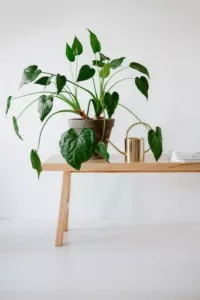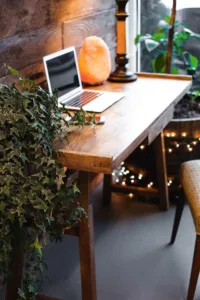I can’t imagine anyone thinking “ugh, plants in my home? No thanks.” The problem isn’t that we don’t want a green home, it’s the idea of having to take care of them that puts most people off. Today, I’m set to convince you that the benefits of having plants outweigh the cons. Well, the con. There is really only one problem with plants: They require care. Once you’ve heard of the many ways plants take care of us, you’ll want to swap your faux plants for the real deal!
If you have pets or children, please be careful of which plants you bring in your house. Some can be deadly when ingested!
Getting rid of pollutants
A 1998 United Nations Development Program estimates that over 2 million humans die each year because of polluted indoor air. (Brennan and Withgott, 2005). So why is our indoor air so polluted?
There are two main types of indoor pollutants; Nitrogen Oxides (NOx) and Volatile Organic Compounds (VOC). According to the EPA, unvented combustion appliances (e.g. gas stoves), vented appliances with defective installations, welding, tobacco smoke and kerosene heaters are the producers of NOx. The EPA even noted that “in homes with gas stoves, kerosene heaters or un-vented gas space heaters, indoor levels [of NOx] often exceed outdoor levels.”
If you’re thinking “Oh, I don’t have any of these in my home”, you won’t feel quite so at ease when it comes to VOCs. Volatile Organic Compounds are a group of carbon-based chemicals that can be found in paints, solvents, upholstery fabrics, carpets and adhesives, varnishes, vinyl floors, cleaning chemicals, air fresheners, cosmetics, fuel oil, and moth balls — so everywhere.
Some of the most common VOCs are benzene, acetone, ethylene glycol, formaldehyde, methylene chloride, perchloroethylene, toluene, xylene, and 1,3-butadiene. They can also be produced during dry cleaning, cooking, smoking, using certain non-electric space heaters, photocopying or printing, using wood burners.
You might already have guessed the solution to this problem. NASA (yes, the space Administration) couldn’t have put it better.
“Since man’s existence on Earth depends upon a life support system involving an intricate relationship with plants and their associated microorganisms, it should be obvious that when he attempts to isolate himself in tightly sealed buildings away from his ecological system, problems will arise…The answer to these problems is obvious. If man is to move into closed environments on Earth or in space, he must take along nature’s life support system.”
Nature’s life support system, a.k.a plants, are great at cleaning our air. In fact, a study by NASA itself shows that plants could be the solution to alleviating the effects of indoor air pollution to a great extent.
In their study, they list the English Ivy as one of the most air purifying plants.
The great news about that is that English Ivy is super easy to grow. It’s even considered an invasive plants as it grows very quickly and will usually spread all over the place with its beautiful latching roots.
Not only does English Ivy remove formaldehyde from indoor air, but it has been shown to be 94% effective in reducing airborne mold.
Another super easy plant to grow is the spider plant. Those things are pretty much impossible to kill and are, therefore, low maintenance.
They actively remove benzene, formaldehyde, carbon monoxide as well as xylene from the air and are, in my humble opinion, must-haves in all homes.
The Barbeton Daisy (a pretty plant with dainty flowers) and the Boston Fern are also great options to purify your home the natural way.
Another dangerous air pollutant is ozone. “Isn’t ozone not that layer we’re desperately trying to protect?”, you might be wondering. In this instance, we’re referring to ground-level ozone. It is called a “secondary” pollutant because it is produced when the two primary pollutants (NOx and VOCs) react in sunlight and stagnant air.
Ozone is known to have significant effects on human health. Exposure to ozone has been linked to premature mortality and a range of morbidity health end-points such as hospital admissions and asthma symptom days.
In a study called “Effectiveness of Houseplants in Reducing the Indoor Air”, three common indoor houseplants, golden pothos (Epipremnum aureum), were used to measure how effective those plants would be at reducing the amount of ozone in a simulated indoor environment. Putting large concentrations of ozone in one room with plants and another without plants, they found that the amount of ozone was reduced Pollutant Ozone” (There’s a mouthful) the snake plant (Sansevieria trifasciata), the spider plant (Chlorophytum comosum), and the golden drastically faster in the room with plants.

Embellishing your home.
Instead of embellishing your home with inanimate objects, give plants the chance to brighten your space. They’ll uplift the mood of any apartment and make for an inviting space.
Whether you want to have your own mini jungle like me or a fern to perk up your desk area; plants are a great way of decorating your home. I personally think there is very little ― if nothing ― more beautiful than nature.
“Cortisol, be gone!”
It’s scientifically proven that plants can help reduce the levels of stress in the human body. Few people know that stress releases cortisol which is known as the “stress hormone”. High levels of it in the body can contribute towards heart disease, hyperglycemia, weakened immune system, adrenal failure, metabolic Issues, fatigue/insomnia among many other issues. By naturally reducing your stress, you’ll be eliminating the amount of cortisol in your body. Plants are definitley a step in the right direction when it comes to reducing stress.
The proud mamma syndrome
Caring for a plant and watching it grow is accompanied by the ‘proud mamma’ syndrome. Every new flower that spurts from my Meyer lemon tree is a celebration and I’ll make sure that What’s App pictures are sent for every spurt of growth. Growing plants can be very rewarding. It can also be a fun activity to do with older children to show them how their day-to-day actions (such as watering their plants) can lead to tangible results(a thriving plant!)

Fresh produce
Produce is often covered in pesticides. Planting your own veg and herbs is a great way to ensure that your food is safe and grown in optimum conditions. Some greens can be grown in a flat and will look pretty at a well-lit window. Courgettes, aubergines and herbs are a few of those. Microgreens are super easy to grow too. They are nutritious and YouTube abounds with tutorials on how to grow them.
Think of the number of times you’ve bought packets of thyme, only to use a twig or two. Having a fresh batch by your window means maximum freshness, no wastage and you know exactly what went into the plant itself.
Free therapy
As creatures who originated from the outdoors; who lived with and against the elements of nature, we are now spending an awful lot of time indoors. Living in cities have to a certain extent estranged us from nature. Having a home filled with plants is a great way of rebuilding this connection with mother nature. We are intrinsically biophiles. We love what the Japanese call ‘shinrin yoku’ ― forest bathing. Being immersed in nature is crucial to our sense of wellbeing but, with cities surrounding us, this connection has become lost. Having a few plants is a good way of rediscovering this. Witnessing the process of budding life, growth, and re-growth; the beautiful cycle of life right at your window, allows us to learn essential lessons from nature. Cultivating (pun intended) a relationship with nature can only help us deal with our own existence in better ways.
The repotting experience
Repotting my plants is an experience in itself for me; it’s a ritual, it’s one that all your senses can focus on. I can’t begin to explain how mentally uplifting it is to dig your fingers into the soil. Much like colouring, repotting your plants doesn’t require a ton of mental effort ― activities like this are prone to making you aware of your more subconscious thoughts or simply a relaxing task.

Getting more productive at home
If you have an office or a studio at home, embellishing it with plants is scientifically proven to increase productivity. According to psychologists in this study, offices devoid of pictures, souvenirs or any other ‘distractions’ are “the most toxic space” you can put a human into.
After 10 years of research, Dr Chris Knight from Exeter University, found that productivity could be increased by 15% when introducing greenery into lean workspaces. “This is because employees who actively engage with their surroundings are better workers.”, he says.
So whether you have an at home office or run your own business, considering plants in workspaces can be prone to excellent results.
The 2015 Human Spaces report also found that employees whose offices included natural elements scored 15% higher for creativity than those whose offices didn’t include such elements
Healing properties of plants
How about bringing nature’s healing properties at home? Some studies have shown that plants accelerate the recovery period of patients in hospitals which in itself a remarkable thing.
Dotting your place with a few ferns can be a great way on creating a healing and peaceful environment.
Optimising your office for productivity
Another study found that different plant colours can stimulate different emotional reactions. “ Dark green colored plants can be used to make a place more relaxing and calming, while the green-yellow and bright green colored plants can be used to make a place more pleasant and exciting and brightness…On the other hand, the red plants can be used in a place where high concentration are required”
If streamlining your routine is important to you, adding plants of specific colours could be a great way of deliberately making sure different spaces in your home are optimised for their purpose.

There you have it; 10 reasons why plants are your live-in best friends. If you’re a newbie to taking care of plants, lean towards some low-maintenance ones — you don’t want to kill your newly sprouting green thumb already. Rome was not built in a day; your green home won’t either. It’s a process. Or to use Anna Wintour’s least favourite word, it’s a journey. Please also keep in mind that some plants are not safe for pets and children. Bringing any plant into your home needs to be done with consideration!

“The True Cost” was a life-changing documentary for Leena. Since then, she blogs about ethical and green living in her free time while drinking copious amounts of coffee and looking after too many house plants.